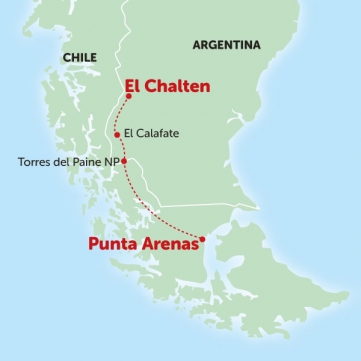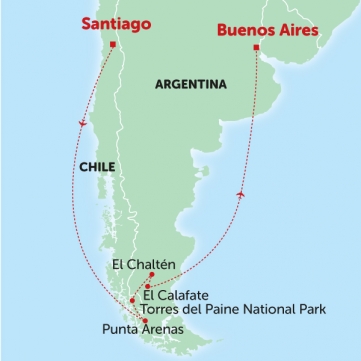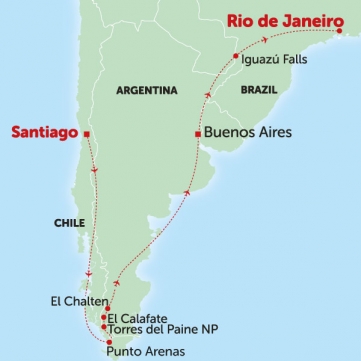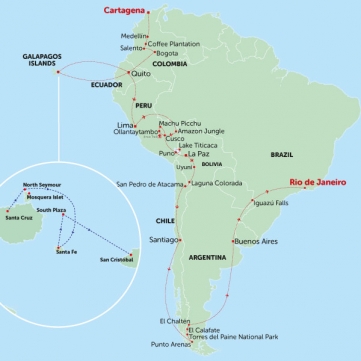Book NOW for $1 £1 €1 • Flexible Payments • No Change Fees • Private Departures Available
- Home >>
- Wildlife in Patagonia
Wildlife in Patagonia
Due to the ecological diversity of Patagonia there exists an abundance of different animals. A combination of huge forested areas, plentiful coastlines and low human activity, wildlife in Patagonia flourishes. Considered a nature lovers paradise, wildlife enthusiasts can discover over 500 species of wildlife living in Patagonia. Spending time in Torres del Paine National Park, you are sure to see frolicking guanacos and prowling foxes. Stop by Lago Argentino for a view of the flamingos that rest there.

Penguins
Patagonia is home to five species of Penguin - Magellanic, Gentoo, Humboldt, Rockhopper and King Penguins. These majestic birds can easily be spotted in the coastal regions and on day trips to various islands around the Patagonian region. The Magellanic Penguin is the only offshore foraging species found in Southern Patagonia, which migrate north during the winter months, while the Gentoo Penguins tend to have smaller colonies and do not migrate, staying in close proximity to their colony year round. The Humboldt Penguin most closely resembles the Magellanic Penguin, and often share their breeding ground. The colonies of Rockhopper Penguins nest on top of sea cliffs and are named after the way they hop along paths.
One of the best places to see penguins is a day trip to Isla Magdalena. The colony of Magellanic penguins here is around 120,000 and you can spend one hour walking around the island viewing these wonderful birds.
Puma
The largest cat that roams Patagonia, the puma is agile, fast and a keen hunter of guanacos. Pumas were almost hunted to extinction after farmers would kill them to protect their livestock, but are now protected in Chile and most notable in Torres del Paine National Park, especially areas where there is very low to no human presence. They can grow to an impressive 2.5 metres in length with long hind legs, perfect for jumping.


Rhea (Ostrich)
Similar in appearance to the ostrich, the lesser rhea is a flightless bird found in Patagonia. Once hunted and eaten by the native people of Patagonia, there now exists two species of reah in Patagonia. They are grassland birds and prefer open land and woodlands. Feeding on grass, fruits, seeds and roots, the rhea are often seen feeding in the same areas as deer and cattle. They roam in groups of up to 30 and can run at an incredible 70 mph, which makes them difficult to capture in motion!
Andean Flamingo
These beautiful, pink hued animals can be seen in various locations in Patagonia, but most notably on the shores of Lago Argentino. The 100 strong colony here feed on algae and other microscopic bacteria as well as plants and often fish. Unfortunately their habitat is changing due to human activity and mining in the area, therefore conservation efforts are underway.
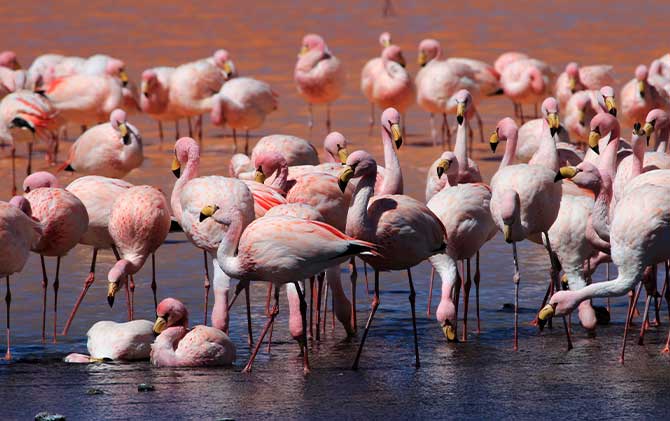

Guanacos
Native to South America and cousins of the llama, guanacos are commonly found all over Patagonia, especially in Torres del Paine National Park and Tierra del Fuego National Park. They live in herds in the mountainous regions, made up of females, young and a dominant male. Their extended neck allows them to pull tough plants from the ground. Unlike llamas who live in hot temperatures at 12,000 feet above sea level, the guanaco happily live in the colder climate of the Andean mountains, and are said to have the largest guanaco population in Argentina.
Whales
Patagonia sits on three different oceans, so of course it is the perfect place for various whale watching opportunities. Four types call the waters around Patagonia their home - the humpback, orca, southern right and blue whale. The latter is of course known as the largest of all the species. They can reach an incredible 30 metres in length and almost 200 tons in weight, making them the largest animal in the world. Also known as the killer whale, orcas are easily recognisable due to their colouring and huge dorsal fins. Various boating day trips in Patagonia will take you to known areas where you have the best chance of viewing whale activity.


Andean Condor
The king of birds, the condor can be seen soaring above the mountains in Patagonia in search of prey. With a wingspan of up to nine feet, the condor is the largest bird in the world and can weigh in at a hefty 15 kilograms. The condors in Patagonia make full use of the windy weather, often gliding on the air currents with little effort. They can easily be recognised by their black colouring, but the males have a distinctive white collar and some white markings on their wings too. Condors play an important role in the ecosystem, often tidying up carcasses of larger animals and picking off the last scraps. They also feed on small animals such as mice and other rodents.
Featured Tours



